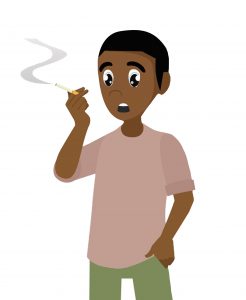
From Smoker to Non-Smoker: Pravin’s Journey to Quitting
Once upon a time, there was a person named Pravin who had been a smoker for many years. Pravin had tried to quit smoking several times before, but had always found it too difficult to quit for good.
He started to visit a group called as “smoking anonymous” who are helping people to quit smoking
They discussed with him how smoking causes health related complications. They told him how smoking is a major cause of preventable illness and death worldwide. They also gave the following examples of the most significant health issues associated with smoking:
Cancer: Smoking is a leading cause of several types of cancer, including lung cancer, bladder cancer, cervical cancer, kidney cancer, and pancreatic cancer.
Heart disease: Smoking is a major risk factor for heart disease, as it damages the arteries and increases the risk of heart attack and stroke.
Respiratory disease: Smoking can cause chronic obstructive pulmonary disease (COPD), which includes chronic bronchitis and emphysema. COPD can lead to difficulty breathing, chronic cough, and reduced lung function.
Reproductive issues: Smoking can cause fertility problems in both men and women. It can also increase the risk of miscarriage, premature birth, and low birth weight in pregnant women.
Dental issues: Smoking can cause dental problems such as gum disease, tooth decay, and oral cancer.
Eye issues: Smoking can increase the risk of cataracts and macular degeneration, which can lead to vision loss.
Skin issues: Smoking can cause premature ageing, wrinkles, and skin damage.
It’s important to note that the health risks associated with smoking are not limited to smokers themselves. Secondhand smoke can also cause health problems in non-smokers, including lung cancer, heart disease, and respiratory issues and this may affect the other members of his family at home including children.
How did the Support Group help?
Everyday Pravin attends the Smoking Anonymous meeting but could not take a stand, however, one day, Pravin made the decision to quit smoking once and for all.
To help with the process, Pravin sought out the support group for smokers who wanted to quit. There, Pravin met others who were going through the same struggle, and they all encouraged and motivated each other to stay strong and resist the urge to smoke.
In addition to the support group, Pravin also made lifestyle changes to make quitting smoking easier. Pravin started exercising regularly, which not only helped to distract
from cravings, but also improved overall health and well-being. Pravin also
made an effort to avoid situations where smoking was prevalent, such as bars and parties.
The first few days and weeks of quitting smoking were tough for Pravin, as the body went through withdrawal symptoms and the mind struggled with cravings.
What are withdrawal symptoms?
Support group made Pravin understand about the withdrawal symptoms of quitting smoking, and guided him about some of the following common symptoms:
- Cravings for nicotine: The brain becomes accustomed to nicotine and when a person stops smoking, the body will crave it.
- Irritability: People who quit smoking may experience irritability or mood swings as a result of nicotine withdrawal.
- Anxiety: Nicotine is a stimulant, and its absence can cause feelings of anxiety.
- Insomnia: Nicotine is a stimulant and can disrupt sleep patterns. When a person quits smoking, they may have trouble sleeping.
- Difficulty concentrating: Nicotine can improve concentration, and its absence can make it harder to focus.
- Increased appetite: Some people gain weight after quitting smoking due to an increased appetite and changes in metabolism.
- Headaches: Nicotine withdrawal can cause headaches or migraines.
- Coughing: As the lungs begin to heal, a person may experience coughing or phlegm production.
- Fatigue: Nicotine withdrawal can cause fatigue or lethargy.
The support group told Pravin that these symptoms are temporary and typically last for a few weeks to a few months.
Handling withdrawal symptoms is an important part of successfully quitting smoking. Here are some strategies that may help
1. Use nicotine replacement therapy: Nicotine replacement therapy (NRT) can help to reduce withdrawal symptoms by providing a low level of nicotine to the body without the harmful chemicals in cigarettes. NRT can take the form of patches, gum, lozenges, inhalers, or nasal sprays, and can be purchased over the counter at most drug stores.
2. Stay busy: Keeping busy with activities can help distract from cravings and reduce the intensity of withdrawal symptoms. Engage in activities that you enjoy or that require concentration, such as reading, exercising, or hobbies.
3. Drink water: Drinking plenty of water can help flush out the toxins from smoking and reduce cravings. It can also help to keep the body hydrated and reduce headaches and nausea.
4. Practice relaxation techniques: Relaxation techniques such as deep breathing, yoga, or meditation can help to reduce stress and anxiety, which can be triggers for smoking cravings.
5. Seek support: Having a support system can be critical to successfully quitting smoking. Reach out to friends, family, or a support group to help with the challenges of quitting smoking.
It’s important to remember that withdrawal symptoms are temporary and will lessen over time. By sticking to a quit plan, using coping strategies, and seeking support, it is possible to successfully quit smoking and improve overall health and well-being.
The benefits of quitting smoking far outweigh the discomfort of withdrawal symptoms.
Pravin also faced several difficulties while quitting smoking, some of which are common to many people who try to quit:
- Withdrawal symptoms: Pravin experienced physical symptoms of withdrawal, such as headaches, nausea, and irritability, as the body adjusted to the absence of nicotine.
- Cravings: Pravin also experienced intense cravings for cigarettes, particularly in situations that were associated with smoking, such as after meals or while socialising with friends who smoked.
- Emotional challenges: Quitting smoking can be an emotional process, as smokers may have used cigarettes as a coping mechanism for stress, anxiety, or other difficult emotions. Pravin had to find new ways to manage these emotions without turning to cigarettes.
- Social pressure: Pravin had to navigate social situations where other people were smoking, and may have felt pressure to join in or felt left out for not smoking.
Despite these challenges, Pravin persevered with the support of the group, healthy habits, and determination to quit smoking.
With the support of the group and the newfound healthy habits, Pravin persevered.
As time went on, the urge to smoke became less and less frequent. Pravin started to notice improvements in breathing, taste and smell, and even saved money by not buying
cigarettes. The support group also became a valuable resource for Pravin to discuss challenges and share successes with.
Did Pravin try to smoke again after quitting?
The million dollar question is did Pravin ever try to smoke again after quitting. However, it is common for people who have quit smoking to have occasional urges or temptations to smoke again. This is because smoking is a highly addictive habit, and the nicotine in cigarettes can create physical and psychological dependence.
If Pravin did experience a relapse and smoked again, it’s important to remember that this is a normal part of the quitting process. Many people who quit smoking experience relapses before ultimately quitting for good. The key is to use the relapse as a learning opportunity, identify the triggers or situations that led to the relapse, and develop new strategies to avoid those triggers or cope with them in healthier ways. Pravin was determined not to smoke again. For that he also took the help of the support group.
Years later, Pravin was still smoke-free and enjoying a healthier life. The journey wasn’t easy, but quitting smoking was one of the best decisions Pravin ever made.


Hello, I want to quit smoking, Is there any group in Jharkhand that can help me to stop smoking?
There are support groups and resources available to help you quit smoking. You can find local community groups, online forums, or reach out to healthcare professionals for guidance and support. Quitting smoking is challenging, but it’s never too late to start. Keep up the good work!